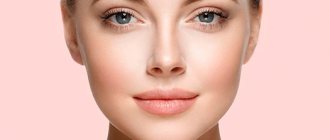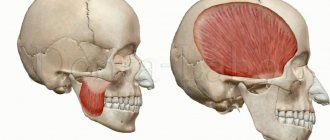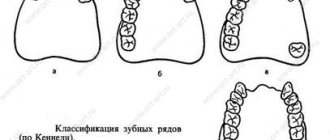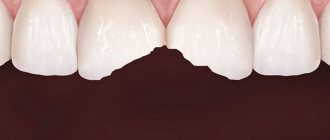- Signs of correct bite
- Types of malocclusion
- Why do you need to correct your bite?
- Until what age can a bite be corrected?
- Ways to correct a bite
- Aligners
- Trainers
- Veneers
- Bracket system
- Types of braces
- Which braces system should you choose?
- How long does it take to correct a bite?
- How to care for braces?
Malocclusion occurs in almost 80% of the Russian population. In a third of cases it requires orthodontic treatment. And it’s not just a matter of aesthetics - if you are often bothered by headaches, earaches and dizziness, then perhaps it’s a malocclusion. An orthodontist deals with the correction and prevention of malocclusions.
The most common misconception about bite is related to age. Many people think that it can only be corrected in childhood, but today, with the advent of new technologies, this can be done at any age.
In this article we will look at the causes and types of malocclusion and why it needs to be corrected. We will also tell you about treatment methods and dispel the most common fears. Orthodontist Olesya Milagina comments on current issues of orthodontic treatment for us.
Signs of correct bite
To begin with, we will show what a normal bite looks like and list the signs by which you can understand that it is normal.
- The main distinguishing feature of a correct bite is the tight contact of the upper and lower jaws when they close. The upper front teeth cover the crowns of the lower ones by a third, that is, the lower incisors come into contact with the palatine tubercles of the upper ones. There is no distance between the upper and lower chewing teeth, and during chewing they are in constant contact.
- Correct bite affects the harmony of facial proportions: the lower and upper jaws are symmetrical.
- There are no speech defects.
- Food is comfortable to bite and chew.
- There is no discomfort or clicking in the jaw joint.
Posing skills and accessories will make a wide face visually narrower
What to do if you need to make a narrow face “here and now”, urgently? For example, you have a photo shoot coming up. Remember how celebrities pose.
The mouth is slightly open, the teeth are open. In this position, the chin drops, the face visually stretches, the cheeks recede a little, the cheekbones stand out and in general the face seems narrower - that’s the whole secret. Just lower the lower part of your face a little – and voila, a great photo is guaranteed!
Look, for example, at how Jennifer Lopez poses:
And here is the result:
Jennifer Lopez
To make your face visually narrower, you can use glasses with square frames. This accessory works in two directions at once. On the one hand, it makes the temple area more massive, and thereby hides a wide face in the cheek area. On the other hand, it distracts the eye from the massive line of the lower jaw.
The same effect can be achieved with side bangs or a voluminous hairstyle.
If temporary measures do not suit you, and you want to narrow your round face for a long time, pay attention to cosmetic methods.
Types of malocclusion
How can you tell if your bite is wrong? Essentially, these are all deviations from the norm that nature has established.
Malocclusion occurs:
- distal - the upper jaw is pushed forward more than the lower jaw;
- mesial - the lower jaw is pushed forward more than the upper jaw;
- deep - the upper teeth overlap the lower ones by more than half their length;
- open - most of the teeth of the upper and lower jaws do not meet;
- cross - the left and right sides of the upper dentition protrude forward unevenly, and the upper and lower teeth meet with cutting edges.
Appearance and bite
The location of the dentition directly affects a person’s appearance. Facial features depend on the shape of the skull, including the jaws. Pathologies that are not treated in a timely manner cause changes in the external image. The most common problems directly related to jaw pathologies are:
- Heavy chin.
- Sunken cheeks.
- Protrusion of lips.
- Open mouth.
- Drooping of the corners of the lips.
- Violation of facial symmetry.
Over time, such anomalies lead to the premature appearance of wrinkles and aging. There are various anomalies, and each of them changes a person's appearance in different ways.
Why do you need to correct your bite?
- Increased abrasion, caries and tooth loss.
Normally, when chewing, the load is evenly distributed across all teeth. When there is a malocclusion, the load on some teeth increases, while on others there is practically no load. On teeth that “work for two,” the enamel wears off faster, chips appear, and the teeth themselves become loose. Teeth that are “resting” are more vulnerable to caries. - Gum diseases.
With an incorrect bite, the teeth can be tilted inward or, conversely, turned toward the lips. Eating or even normal conversation can injure the inside of the cheeks and tongue. The gums also suffer: the volume of tissue gradually decreases, exposing the roots of the teeth. - Diseases of the temporomandibular joint.
Incorrect positioning of the incisors over time leads to displacement of the jaw joints relative to each other. The pathology is accompanied by muscle spasms, bruxism, crunching and clicking while eating or talking. - Diseases of the food tract.
The bite is responsible for chewing and swallowing, and defects in the bite disrupt this process. Poorly chopped products are an additional burden on the gastrointestinal tract, which provokes gastritis, enterocolitis and problems with stool. - Breathing problems and ENT diseases.
The accumulation of bacteria in the mouth during an open bite can cause sinusitis, sinusitis, otitis media, and sore throat. - Communication problems and complexes.
For 60% of patients, braces are aesthetics; for the remaining 40%, it is either the functionality of the masticatory apparatus, or a solution to a problem with the temporomandibular joint, or a preparatory stage before prosthetics.
Causes of deep bite
Heredity
One of the child’s parents may have a pathology of distal occlusion or other problems that affect its development in the offspring.
For example, there are such variants of the abnormal structure of the parent’s face, which can lead to a deep bite in the child:
- Macrogeny.
The upper jaw is significantly enlarged, and the lower jaw is developed normally. A large upper jaw is a dominant trait that is transmitted genetically.
- Microgenia.
The lower jaw is underdeveloped, while the upper jaw is developed normally. This situation indicates chromosomal disorders, for example, Patau syndrome or Edwards syndrome.
Pathologies of intrauterine development and the postpartum period
The formation of the jaw system occurs approximately in the 5th week of pregnancy. If a woman is diagnosed with an intrauterine infection, fetal hypoxia, a delay in its development and other similar pathologies, this may subsequently cause a distal bite.
Jaw growth, taking into account genetically determined data, begins after birth, during breastfeeding. Its absence or incorrectly similar nipples (the holes of which are too large, as a result of which the child does not make sucking efforts) can also affect the condition of the teeth, as well as the following problems:
- hypotrophy,
that is, the baby’s lack of weight in relation to his height.
- Rickets.
This disease is associated with disorders of bone formation (bones do not develop quickly enough). It most often occurs in infants and young children.
- Defects of the musculoskeletal system.
For example, muscular torticollis, postural disorders, as well as other pathologies of bone tissue.
Important!
A deep bite can appear due to the child’s bad habits - frequent and excessive sucking of a pacifier and/or finger, biting the lip.
Disturbances in dental development
The following dental pathologies can provoke distal bite:
- Super eruption or extrusion
(“rabbit” teeth, that is, excessively elongated front incisors of the upper jaw).
- Insufficient eruption of lateral teeth
due to early loss of lateral primary teeth (which ideally fall out around 9–12 years of age).
- Loss of molars at an early age.
Permanent back teeth usually appear before the age of 13.
- Increased abrasion.
We are talking about the side teeth, which wear out much faster than normal. Most often this is associated with bruxism - active grinding, for example, while eating or sleeping.
Ways to correct a bite
Today there are four ways to correct a bite and one way to carefully disguise the problem.
- Aligners
- Trainers
- Bracket systems
- Surgical intervention
We have listed these methods in order from easiest to most difficult. You must understand that each case is individual, and depending on this, the doctor will select the optimal bite correction system. You can hide an unaesthetic bite with the help of veneers - we will also talk about them.
Aligners
Removable aligners that are created from dental impressions. The most modern way to correct a bite, which is suitable for the treatment of simple disorders.
After drawing up a treatment plan, the patient receives 3–5 sets of aligners of varying stiffness. The mouth guard is designed to last for two weeks, and then it needs to be changed to the next one, and so on until the final result. The course of treatment lasts on average 4–8 weeks.
Aligners need to be worn 24 hours a day, and this may not be comfortable for everyone. They are not suitable for deep bites. The mouthguard is designed so that it is “one step” ahead of the current position of the teeth in the dentition. Therefore, after putting it on, pressure is felt, which is evenly distributed throughout the jaw. Aligners consist of an elastic transparent material, so they are invisible to others, unlike braces.
Trainers
Removable silicone mouth guards for two jaws, which help correct a simple bite or consolidate the result. You need to wear the trainer during sleep and during the day for up to 4 hours.
Veneers
The characteristics are similar to crowns, but they are installed only on the front surface of the tooth in the form of a thin plate on a special dental glue.
Veneers can be composite, ceramic or zirconium. The first two types last about 10 years. Products made of zirconium dioxide with external porcelain coating - up to 15 years.
Veneers eliminate defects that arise as a result of cracks or damage to the integrity of teeth. A visually straight dentition is formed.
For the patient, the result of orthodontic treatment is aesthetics, and for the doctor, it is functionality. If your teeth are just crooked and your bite is perfect, you can get veneers or crowns. In other cases, you cannot do without braces: veneers do not correct the position of the teeth, but only mask their external imperfections.
Bracket system
Braces are small clasps that are attached to the teeth with a special composite glue. A metal arch is placed in the grooves of the braces - the most important element of the braces system. The arch has the shape of a regular dentition. She pulls her teeth, setting them in the correct position. In order for the bracket system to successfully complete its work, it is important to periodically change the arches to more elastic ones.
The doctor fixes the arch on the braces with special rubber bands - ligatures. Depending on the task at hand and the required force that will act on each tooth and jaw as a whole, the orthodontist can choose metal or elastic ligatures. The latter have a clear advantage - when they are changed, you can get rid of the bacteria accumulated under them.
Increased salivation in the first days after installation is a good reaction of the body. The tongue contains sensory neurons that, when food appears in the mouth, send signals to the brain to turn it into a food bolus. When braces are put on your teeth, at first the brain perceives them as food. This is the body’s reflex that there is something in the mouth, which means it needs to be treated with saliva in order to then swallow it. After some time, the salivary glands will get used to it.
Does it hurt to wear braces?
The first days are unusual, but not painful. But if braces scratch your lips and cheeks, you shouldn’t tolerate it. “ Make an appointment with your orthodontist. Sharp elements can be corrected with special materials and filled with special wax
“, our expert advises.
The same applies to tooth sensitivity: sign up for a diagnosis. It is possible that areas of demineralization have appeared. Depending on what the teeth react to, further treatment will depend.
Types of braces
Braces are classified according to the following criteria:
- material (metal, plastic, ceramic and sapphire);
- technique (classical and self-ligating, without ligatures);
- Place of installation (on the outer surface of the teeth - vestibular, on the inner surface - lingual).
Metal braces
Despite the fact that these are the oldest braces systems, they are still popular, and not only because they are the cheapest. Their main advantage is the minimal friction force between the groove and the arc, the magnitude of which largely determines the duration of the entire treatment.
The only negative is that such braces are noticeable on the teeth. However, modern designs differ from their ancestors - they are smaller and more convenient.
Plastic braces
Second after metal ones in the price range. Since plastic itself is not strong enough, the design has metal grooves. Their disadvantage is that such braces are stained by coffee, tea and other coloring products. They are also more fragile than others. However, plastic braces come in a variety of colors and shapes and are therefore popular in pediatric orthodontics.
Ceramic braces
More expensive, but stronger than plastic ones. The color matches the color of the teeth, which makes them almost invisible. Their disadvantage is higher friction between the arch and the bracket slot, which can increase the duration of treatment.
Sapphire braces
Artificial sapphires are used to make them. They are transparent and shimmer beautifully in certain lighting. This design will appeal to those who are sensitive to aesthetics.
Combined braces
Consist of several materials. In the smile area it can be ceramics or sapphires, and in the chewing area it can be metal.
Lingual braces
They are attached to the inside of the teeth and are invisible to others. Their main disadvantage is their high cost. Also, at first they may interfere with diction, but after 2-3 weeks the language adapts and the problem goes away.
Video about bruxism and hypertonicity of the masticatory muscles.
Tension of the platysma muscles visually makes the oval heavier, “pulling” the soft tissue down, also leading to a change in the shape of the face and asymmetry. The cause of the resulting defects - muscle hypertension - is corrected with botulinum therapy. Changes in muscle activity in the face and body can be associated with poor posture, curvature of the spine, and the “short leg” symptom. In these situations, the formation of a beautiful oval is carried out jointly with specialists in related specialties: dentists, neurologists, orthopedists.
An increase in the width and/or volume of the chin can lead to a visual reduction in the size of the lips or a change in the visualization of their shape. Therefore, correction of the chin area is most often carried out together with lip correction, simultaneously or in stages.
It has been noted that at different periods of life, chronological changes in tissues of close relatives are very similar, which in some cases can be one of the guidelines for the doctor when planning a course of procedures. For example, if in a young patient a slight heaviness of the mental area becomes noticeable due to an increase in the volume of adipose tissue, and the mother and/or grandmother already have a pronounced fat trap in the submental area, then the necessary set of measures should be taken in advance to correct it and prevent the further development of pronounced visual aesthetic defect.
Dividing the face into upper, middle and lower thirds is convenient in practical work for understanding the need to place individual zonal dominant accents and their influence on the perception of the image as a whole. And the lower third of the face is very important in this regard.
The most common patient complaints regarding changes in the lower third of the face:
- the appearance of wrinkles;
- increased expression of physiological folds;
- protruding bones;
- visually detectable vasodilation;
- drooping corners of the mouth and decreased lip volume;
- changing the shape of the chin;
- soft tissue ptosis;
- deformation of the oval of the face.
The most common wishes of patients for correction:
- provide lifting of soft tissues of the face;
- reduce the depth of folds and wrinkles;
- improve the oval of the face;
- change (reduce or increase) the width of the face;
- raise the corners of the mouth;
- adjust the shape of the lips and chin;
- harmonize the appearance (for example, create a more feminine, sensual image: for this, the chin is rounded during the modeling process to remove sharpness. When creating a male brutal image, the facial sculpture, on the contrary, is sharper and wider).
The desire to look young and well-groomed is common to both men and women. Youth and well-groomed skin are, first of all, good skin quality: uniform color, smooth texture, fit, absence of wrinkles, folds, neoplasms and pathologically dilated blood vessels. One of the signs of youth is also the well-defined angles of the lower jaw. If the patient has excess subcutaneous adipose tissue and/or severe ptosis, this important feature is “erased.”
In practical work, the doctor should take into account the characteristics of the chin area. The skin here is thickened and inactive due to fibrous strands going deep, penetrating the subcutaneous fatty tissue. Often with involutional changes there is a significant increase in skin pattern and hyperkeratosis. Therefore, before moving on to beauty, you need to work on the quality of your skin. For this purpose, for example, laser and radio wave methods are used, combining them with injection biorevitalizing procedures. In the presence of pathologically dilated vessels or age spots - phototechnology.
If the tissues are thinned, then muscle activity is reflected on the skin in the form of “pits and tubercles”, the surface of the skin looks “shrunken”, dynamic folds are formed, which subsequently turn into deep static ones. In such situations, botulinum therapy is optimal to correct unwanted muscle activity. And only at the very end, subdermal injection of filler is performed in order to smooth out folds and improve the aesthetic perception of this area.
Which braces system should you choose?
The least expensive and most proven option is metal braces. Plastic ones are also inexpensive, but they are inferior in strength to metal ones. If aesthetics are more important to you, opt for more expensive ceramic, sapphire or lingual braces.
As for “internal” braces, their only difference from all others is the aesthetic factor. One of the inconveniences is that such braces change the diction, they are more difficult to care for and they are not suitable for everyone. You need to have an almost perfect bite: just “uneven teeth.”
Distal bite
Distal occlusion is one of the most common problems. Appears in two variants:
- The upper incisors protrude above the lower ones and are slightly inclined forward. As a result, a sagittal gap is formed (a gap between the rows).
- The upper incisors protrude above the lower ones, but are tilted back, camouflaging the gap.
Outwardly, it manifests itself not only as an ugly smile. Distal occlusion greatly affects not only the face, but even a person’s posture. The most common changes in appearance with distal occlusion are:
- Beveled profile. If the upper teeth lean back rather than forward, the facial profile may be concave, with thin lips that seem to be drawn inward.
- Double chin. It is especially pronounced in obese people, but can also manifest itself in patients with normal physique.
- Protruding upper lip. It happens with any type of distal bite.
- Mental fold. Develops in the presence of a sagittal fissure or with a deep bite. In this case, the lower lip seems to be folded under the upper incisors, resulting in the formation of a pronounced chin fold.
For people with distal occlusion, a forward tilt of the head is typical. Outwardly, it looks like a person is stretching his neck forward. Patients are prone to various postural disorders, as the body tries to compensate for the pathology in this way. Thoracic kyphosis, protruding stomach, elongated neck are the most common disorders.
If you have a problem similar to that described in this article, be sure to contact our specialists. Don't diagnose yourself!
Why you should call us now:
- We will answer all your questions in 3 minutes
- Free consultation
- The average work experience of doctors is 12 years
- Convenient location of clinics
Single contact phone number: +7
Make an appointment
How long does it take to correct a bite?
Each case is individual, so without visiting a doctor it is impossible to say how long treatment will take.
The minimum treatment takes a year for the bone to grow and the teeth not to come back. The result needs to be stabilized. Patients often tell me after two months of wearing braces: “I want to take them off, everything is already straight for me!” But this is appearance. The jaw bones must anchor the teeth into their new position.
The duration of treatment also depends on the patient. The orthodontist puts a certain force into the braces, which weakens by the next visit. That is why it is important to strictly visit the doctor once a month so that you do not have to prolong the course of treatment.
My teeth began to loosen. Something is going wrong?
Loose teeth after installation should not scare you. The teeth will be in motion throughout the treatment period. Essentially, we move our teeth: somewhere the bone dissolves, somewhere it appears. Six months after treatment, the teeth will return to normal.
The purpose of braces is to change the position of hard and soft tissues adjacent to the tooth. But this is not enough to correct the bite. Teeth may move back apart some time after braces are removed if a retention device is not in place. After correction, retainers must be installed to keep the teeth stable in their new position. If this is not done, the effect of wearing braces will gradually disappear.
Do exercises help narrow a face with wide cheekbones?
To narrow the face, face-building instructors recommend training the muscles of the cheek-zygomatic region, and in theory, the exercises can have a good effect.
Facial fitness or a new gadget for facial gymnastics.
We will not dissuade you from gymnastics, because keeping your facial muscles toned is useful in any case.
Unfortunately, you won’t be able to “pump up” just one or a couple of muscles in isolation. To one degree or another, all groups of facial muscles will be loaded, including those zones that expand the face.
How to care for braces?
Caring for braces requires care and discipline. We talked about it in more detail in a separate article. After installing braces, the doctor will tell you how to live now. We will indicate the most important things.
- Always have brushes and a single-tuft brush on hand.
- Add a waterpik to your arsenal.
- If you are not sure that you have brushed your teeth well, use an indicator tablet. After brushing your teeth, the tablet must be dissolved in your mouth. The areas where plaque remains will turn blue. These areas need to be cleaned again.
- Avoid very hot and very cold drinks. Braces, like enamel, do not like sudden temperature changes.
- To prevent braces from coming off, follow a diet. Eliminate nuts, toffees, seeds, and flour from your diet. Apples and other hard fruits should not be bitten off, but cut into small pieces and placed on the chewing teeth.
Lips
The features and techniques of lip correction are very diverse, and their choice depends on the patient’s age, style type (the work is carried out as part of an image modeling program), the presence of asymmetry, etc. However, this is a topic for a separate article. In the context of this material, I would like to focus on the goals of correction. They are determined not only by the wishes of the patient, but also by the characteristics of individual features of his face, their proportional and dynamic correspondence to each other.
Goals of lip correction:
- restoration of lost volume due to age-related changes;
- asymmetry correction;
- changing the shape if the patient does not like it or does not match his facial features;
- giving them naturalness after unsuccessful previous corrections.
The dynamic component of the image is most evident thanks to the lips. Large or small, wide or narrow, young or old, lips are the center of emotional perception. Therefore, it is very important to carry out correction taking into account the individual characteristics of the patient’s facial expressions.
Filler introduced without taking into account muscle tension and facial activity of the lips can create an artificial effect. A striking example is the smoothing of natural relief and a tense smile, which can be present even when the lips are relaxed and at rest.









